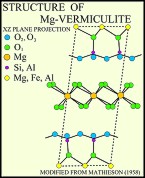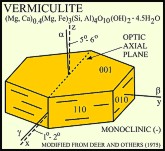 |
 |
A Laboratory Manual for X-Ray Powder Diffraction
 The structure of Mg-saturated vermiculite resembles talc in that it contains a central octahedrally-coordinated layer of Mg ions that lie between two inwardly pointing sheets of linked tetrahedra (Mathieson, 1958). These silicate layers are normally separated by two sheets of interlayer water molecules arranged in a distorted hexagonal fashion. Progressive removal of this interlayer water results in a series of less hydrated phases that include the 14.36
angstrom lattice with two sheets of water molecules, a 11.59 angstrom lattice with a single sheet of water molecules, and a 9.02 angstrom lattice from which all water has been removed (Walker, 1975). Inasmuch as the layers are electrically neutral and interlayer cations occupy only about one-third of the available sites, cohesion between the layers
is typically weak.
The structure of Mg-saturated vermiculite resembles talc in that it contains a central octahedrally-coordinated layer of Mg ions that lie between two inwardly pointing sheets of linked tetrahedra (Mathieson, 1958). These silicate layers are normally separated by two sheets of interlayer water molecules arranged in a distorted hexagonal fashion. Progressive removal of this interlayer water results in a series of less hydrated phases that include the 14.36
angstrom lattice with two sheets of water molecules, a 11.59 angstrom lattice with a single sheet of water molecules, and a 9.02 angstrom lattice from which all water has been removed (Walker, 1975). Inasmuch as the layers are electrically neutral and interlayer cations occupy only about one-third of the available sites, cohesion between the layers
is typically weak.
 Vermiculites are usually formed in sediments by the alteration of micaceous minerals (biotite and chlorite to trioctahedral vermiculite; muscovite to dioctahedral vermiculite; Moore and Reynolds, 1997). However, vermiculites formed through the alteration mica are comparatively rare in marine sediments because the K of sea water readily contracts them (Deer and others, 1975). Where present, marine vermiculites are probably derived from volcanic material, chlorite, and hornblende.
Vermiculites are usually formed in sediments by the alteration of micaceous minerals (biotite and chlorite to trioctahedral vermiculite; muscovite to dioctahedral vermiculite; Moore and Reynolds, 1997). However, vermiculites formed through the alteration mica are comparatively rare in marine sediments because the K of sea water readily contracts them (Deer and others, 1975). Where present, marine vermiculites are probably derived from volcanic material, chlorite, and hornblende.
Although dentification of vermiculite can be problematic because its characteristics vary, most Mg-saturated and hydrated vermiculites yield a 14-angstrom 001 peak that does not expand upon solvation with ethylene glycol. The 001 peak of dioctahedral vermiculite collapses to about 12 angstrom after heating to 400 C and to about 11 angstroms after heating to 550 C. The 001 peak of trioctahedral vermiculite collapses to about 10 angstroms after heating to 400 C, but shows no change or only a slight additional collapse after heating to 550 C. Dioctahedral and trioctahedral vermiculites may also be differentiated based on 060 diffraction lines of 1.50 angstroms and 1.52-1.54 angstroms, respectively (Douglas, 1989).
| X-ray powder diffraction patterns of oriented-aggregate mounts showing the effects of standard treatments on: | |